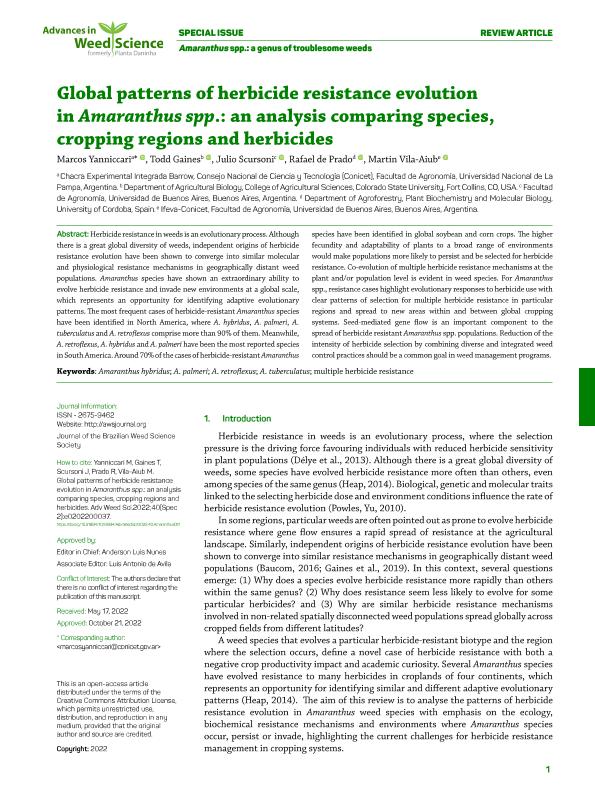Artículo
Global patterns of herbicide resistance evolution in Amaranthus spp.: an analysis comparing species, cropping regions and herbicides
Yanniccari, Marcos Ezequiel ; Gaines, Todd; Scursoni, Julio Alejandro; De Prado, Rafael; Vila Aiub, Martin Miguel
; Gaines, Todd; Scursoni, Julio Alejandro; De Prado, Rafael; Vila Aiub, Martin Miguel
 ; Gaines, Todd; Scursoni, Julio Alejandro; De Prado, Rafael; Vila Aiub, Martin Miguel
; Gaines, Todd; Scursoni, Julio Alejandro; De Prado, Rafael; Vila Aiub, Martin Miguel
Fecha de publicación:
12/2022
Editorial:
Brazilian Weed Science Society
Revista:
Advances in Weed Science
ISSN:
2675-9462
Idioma:
Inglés
Tipo de recurso:
Artículo publicado
Clasificación temática:
Resumen
Herbicide resistance in weeds is an evolutionary process. Although there is a great global diversity of weeds, independent origins of herbicide resistance evolution have been shown to converge into similar molecular and physiological resistance mechanisms in geographically distant weed populations. Amaranthus species have shown an extraordinary ability to evolve herbicide resistance and invade new environments at a global scale, which represents an opportunity for identifying adaptive evolutionary patterns. The most frequent cases of herbicide-resistant Amaranthus species have been identified in North America, where A. hybridus, A. palmeri, A. tuberculatus and A. retroflexus comprise more than 90% of them. Meanwhile, A. retroflexus, A. hybridus and A. palmeri have been the most reported species in South America. Around 70% of the cases of herbicide-resistant Amaranthus species have been identified in global soybean and corn crops. The higher fecundity and adaptability of plants to a broad range of environments would make populations more likely to persist and be selected for herbicide resistance. Co-evolution of multiple herbicide resistance mechanisms at the plant and/or population level is evident in weed species. For Amaranthus spp., resistance cases highlight evolutionary responses to herbicide use with clear patterns of selection for multiple herbicide resistance in particular regions and spread to new areas within and between global cropping systems. Seed-mediated gene flow is an important component to the spread of herbicide resistant Amaranthus spp. populations. Reduction of the intensity of herbicide selection by combining diverse and integrated weed control practices should be a common goal in weed management programs.
Archivos asociados
Licencia
Identificadores
Colecciones
Articulos(IFEVA)
Articulos de INST.D/INV.FISIOLOGICAS Y ECO.VINCULADAS A L/AGRIC
Articulos de INST.D/INV.FISIOLOGICAS Y ECO.VINCULADAS A L/AGRIC
Citación
Yanniccari, Marcos Ezequiel; Gaines, Todd; Scursoni, Julio Alejandro; De Prado, Rafael; Vila Aiub, Martin Miguel; Global patterns of herbicide resistance evolution in Amaranthus spp.: an analysis comparing species, cropping regions and herbicides; Brazilian Weed Science Society; Advances in Weed Science; 40; spe2; 12-2022; 1-14
Compartir
Altmétricas



